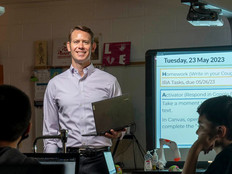4 Ways to Get a K–12 Student Help Desk Going
As one-to-one programs undergo significant growth in K–12 schools across the country, IT teams will need extra support to manage and maintain the resulting surge of student devices.
A majority of administrators from elementary schools (64 percent), middle schools (83 percent) and high schools (85 percent) report they have already implemented a one-to-one initiative or see it as a primary goal, according to a 2018 K–12 leadership survey from the Consortium for School Networking.
Some enterprising school administrators even enlist students to run school help desks, providing staff with the assistance they need while also giving students the chance to learn technical skills through a hands-on approach.
4 Best Practices for a Successful Help-Desk Program
When Burlington High School in Massachusetts launched its rollout of 1,000 personal tablets, Instructional Technologist Jennifer Scheffer recruited students to run and manage an IT help desk.
The program became one of the first of its kind in the country and required Scheffer — now an instructional technology specialist at Burlington’s Fox Hill Elementary — to adapt the program as new lessons were learned.
“Launching it didn’t come without challenges,” Scheffer writes in a blog post published by ISTE. “Sustaining its success for both students and staff requires continued attention and adjustments as the technology needs of our school community change over time.”
I’ve seen many schools find success in starting their own student-run help desks. It’s a smart exercise that results in so many benefits beyond lifting some burdens from IT.
Drawing from her own experiments and trials, Scheffer identifies four key steps other K–12 schools can use to develop a similar program in their districts. I think it’s solid advice that everyone should read:
-
Pinpoint learning outcomes and design the curriculum: When starting a student help desk program, facilitators should map out the educational benefits they want their students to take away, writes Scheffer. At BHS, Scheffer used the Massachusetts Technology Literacy Standards (now part of the expanded Massachusetts Digital Literacy and Computer Science Standards) and Tony Wagner’s Seven Survival Skills as a guide to establish a program that could benefit students as well as the school. “The BHS Help Desk curriculum strives to give students real-world learning opportunities,” Scheffer writes. “Just like an actual working environment, we expect students to be self-driven, independent and capable of managing multiple projects.”
-
Develop learning activities and assessments: While hands-on tasks will be a major part of the learning process for student help desk volunteers, facilitators need to design tests to reinforce on-the-job skills to make sure students retain the information they learn. “Members of a student tech team should graduate from their respective programs with both technical and soft skills that are highly sought after by employers, and their online resumes should incorporate their tech team accomplishments along with their other work experiences,” writes Scheffer.
-
Identify, recruit and promote the team: Technology savvy students are not the only ones who can, and should, participate in these programs. Because help desks are volunteer-based, marketing is a crucial way to get students interested in joining. Bringing in talented writers, graphic designers or videographers can be a great way to boost interest in the help desk program, while also giving students who are not interested in fixing devices a chance to participate.
-
Establish a mission, purpose and goals: Giving students ownership in the help desk can increase student engagement, as well as help schools improve the program over time. Scheffer suggests facilitators work with their students to create a program mission statement, getting input from students about what they want to get out of running a help desk. It’s also important to balance student autonomy and classroom structure to let students experiment with new ways to streamline help desk services while still ensuring they walk away with core life skills.
This article is part of the "Connect IT: Bridging the Gap Between Education and Technology" series. Please join the discussion on Twitter by using the #ConnectIT hashtag.
![[title]Connect IT: Bridging the Gap Between Education and Technology [title]Connect IT: Bridging the Gap Between Education and Technology](http://www.edtechmagazine.com/k12/sites/default/files/articles/2014/05/connectit.jpg)








